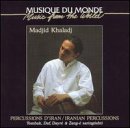| All Artists: Madjid Khaladj Title: Iranian Percussions Members Wishing: 1 Total Copies: 0 Label: Buda Musique Release Date: 3/6/2001 Album Type: Import Genres: International Music, Pop Styles: Middle East, Iran Number of Discs: 1 SwapaCD Credits: 1 UPC: 723724068827 |
Search - Madjid Khaladj :: Iranian Percussions
 | Madjid Khaladj Iranian Percussions Genres: International Music, Pop
|
Larger Image |
CD Details |
CD ReviewsBeats of mythology Nader F. | Brookline, MA | 12/22/2003 (5 out of 5 stars) "Madjid Khaladj's percussion work give voice to the stretched skin on daf, drum, and dayereh in ways that are abstractions of the human voice in the way that earthen vases and pots are abstractions of human existence for Khayyam.I became familiar with this amazing artist only a year ago, and can't stop spreading the pleasure I've derived from listening to him. Actually I heard his tombak during a 1994 performance of the Paris based Mostagh group, was truly taken by it but didn't realize who it was until I got this CD last year. The true measure of percussionists in Iran has been Hossein Tehrani, who in the fifties and sixties raised the level of the tombak to that of a solo instrument. He showed everyone the capability of the percussion to suggest implied melodies and absent voices which it would have accompanied were they present in a give piece.Madjid Khaladj makes these abstracted suggestions come alive, especially on the daf, the larger of the three main stretch skinned percussive instruments of Iran.The quality of the samples here doesn't come close to giving the the true depth of his performance. I urge Amazon to remedy this problem. At home, a VERY good set of speakers or headphones are essential to really appreciate the subtleties of these compositions. These are mystical journeys into historical tales, mythologies, and beliefs. The recording's acoustical quality is excellent and a good system will make you smile unashamedly at Khaladj's virtuosity.A deviation from skin percussion is Parandeha-ye Royaha (birds of dreams) in which he uses the zang-e sar-angoshti (finger cymbals) to recreate the "conference of the birds" poem by the 12th century poet Attar (this is my interpretation). You can almost hear the echoes of the birds in the distant trees.Marpitch (serpentine) is so rich with imagery that my group has been discussing its story for the last three months. We have had vivid pictures of the story of Adam and Eve emerge from it, as well as Khayyam's poetry, and the implications of unity of time and space. See what you hear there. For those not familiar with traditional tombak compositions, Paye Dar Doran (In the realm of the ages) is a great lesson,
demonstrating how verbal poetic rhythms are abstracted into percussive compositions, giving a poem its voice.You will be pleased with the broad appeal of this artist. He uses persian instruments, but in his hand, they speak universal passages." |

 Track Listings (8) - Disc #1
Track Listings (8) - Disc #1